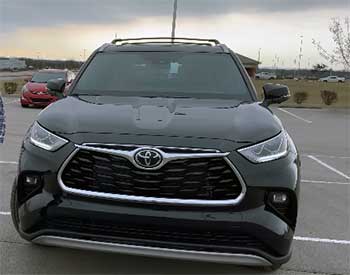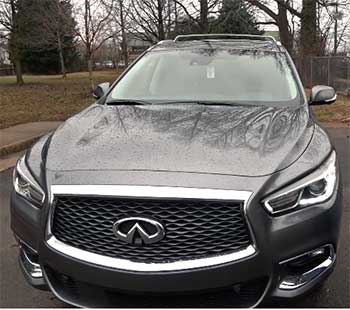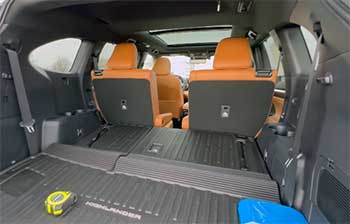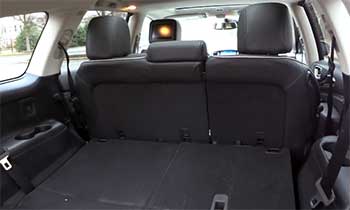I’ve been on the hunt for a midsize SUV that balances family-friendly practicality with a touch of luxury, and two models keep popping up: the 2025 Infiniti QX60 and the 2025 Toyota Highlander. Both promise space, comfort, and versatility, but which one truly delivers?
In this article, I’ll compare their features, performance, and value, weighing pros and cons to help you decide which SUV suits your needs. From engines to interiors, safety to price, I’ll break it all down to guide your choice.
Comparison Table of Infiniti QX60 vs. Toyota Highlander
| Feature | Infiniti QX60 | Toyota Highlander |
| Starting MSRP | $51,550 | $41,315 |
| Engine | 2.0L Turbo 4-cylinder, 268 hp | 2.4L Turbo 4-cylinder, 265 hp |
| Transmission | 9-speed automatic | 8-speed automatic |
| Fuel Economy (City/Hwy) | 22/27 MPG (FWD), 21/26 MPG (AWD) | 22/29 MPG (FWD), 21/28 MPG (AWD) |
| Cargo Space (Behind 3rd Row) | 14.5 cu. ft. | 16.0 cu. ft. |
| Max Cargo Space | 75.4 cu. ft. | 84.3 cu. ft. |
| Seating Capacity | 7 (6 with captain’s chairs) | 8 (7 with captain’s chairs) |
| Front Legroom | 42.1 in. | 42.0 in. |
| Second-Row Legroom | 37.7 in. | 38.7 in. |
| Third-Row Legroom | 28.0 in. | 28.0 in. |
| Towing Capacity | Up to 6,000 lbs (with package) | Up to 5,000 lbs |
| NHTSA Safety Rating | 5 stars | 5 stars |
| Infotainment Screen | 12.3-inch touchscreen | 8-inch (12.3-inch on higher trims) |
| Standard USB Ports | 8 | 5 |
| Reliability (J.D. Power) | Average (80/100) | Above Average (85/100) |
| Warranty | 4 yrs/60,000 miles (basic), 6 yrs/70,000 miles (powertrain) | 3 yrs/36,000 miles (basic), 5 yrs/60,000 miles (powertrain) |
My Journey into the Midsize SUV World
Shopping for a midsize SUV feels like navigating a maze. You want space for the kids, gear, and maybe even the dog, but you also crave comfort and a bit of style. The Infiniti QX60 and Toyota Highlander both caught my eye for their three-row seating and family-oriented designs, but they cater to slightly different vibes.
The QX60 leans into luxury, while the Highlander banks on Toyota’s reputation for reliability and value. Let’s break down what makes each one tick, starting with their designs and how they feel on the road.
Exterior Design: Style vs. Substance


When I first saw the Infiniti QX60, its sleek, polished look screamed sophistication. The 2025 model sports a bold grille, slim LED headlights, and a floating roof effect thanks to blacked-out pillars. It’s the kind of SUV that turns heads at the school pickup line. The top-tier Autograph trim, with its black roof and 20-inch wheels, feels like a statement piece.
But I noticed the QX60 is wider and slightly longer (198.2 inches vs 194.9 inches) than the Highlander, which can make parking in tight spots a bit trickier.
The Toyota Highlander, on the other hand, has a more rugged, practical aesthetic. Its 2025 design is sharp but less flashy, with a prominent front fascia and available 20-inch wheels on the XSE trim.
The Highlander’s shorter length makes it easier to maneuver in crowded lots. While it doesn’t exude the QX60’s luxury, it feels approachable, like a trusty companion for weekend adventures.
QX60 Pros:
- Elegant design, premium presence, upscale trim options.
QX60 Cons:
- Larger footprint can be cumbersome in tight spaces.
Highlander Pros:
- Practical styling, easier to park, sporty XSE trim.
Highlander Cons:
- Less luxurious appearance compared to QX60.
Interior Comfort: Where You’ll Spend Your Time

Stepping inside the QX60 feels like entering a high-end lounge. The quilted leather upholstery (especially in the Autograph trim) and available ash wood trim give it a refined edge.
The front seats are spacious, with 42.1 inches of legroom, and the second row slides for easy access to the third row.
However, the third row’s 28 inches of legroom is tight for adults—better suited for kids. Cargo space is decent, with 14.5 cubic feet behind the third row and 75.4 cubic feet with both rows folded, but it lags behind the Highlander. The QX60’s eight USB ports and 12.3-inch touchscreen make it a tech haven, and the available 17-speaker Bose system is a treat for audiophiles.

The Highlander’s interior is practical but less opulent. The base trims have fabric seats, though higher trims like Limited offer leather. With 42.0 inches of front legroom and 38.7 inches in the second row, it’s slightly roomier for rear passengers.
The third row matches the QX60’s 28 inches, so it’s equally cramped for adults. Cargo space shines, with 16 cubic feet behind the third row and 84.3 cubic feet max, making it better for hauling gear.
The standard 8-inch touchscreen (12.3-inch on higher trims) is user-friendly, but only five USB ports feel stingy compared to the QX60.
QX60 Pros:
- Luxurious materials, more USB ports, premium audio options.
QX60 Cons:
- Less cargo space, cramped third row for adults.
Highlander Pros:
- More cargo room, slightly roomier second row, practical layout.
Highlander Cons:
- Fewer USB ports, less upscale materials in base trims.
Performance: Power and Efficiency
Under the hood, the QX60’s 2.0-liter turbo four-cylinder engine pumps out 268 horsepower and 286 pound-feet of torque, paired with a smooth nine-speed automatic. It’s a step down from the previous 295-horsepower V6, but I found it peppy enough for daily driving.
The QX60 accelerates to 60 mph in about 7.5 seconds. Fuel economy is solid at 22 MPG city and 27 MPG highway (24 combined FWD), and it uses premium unleaded fuel for optimal performance. The QX60’s towing capacity hits 6,000 pounds with the right package, perfect for small trailers.
The Highlander’s 2.4-liter turbo four-cylinder delivers 265 horsepower and 310 pound-feet of torque, mated to an eight-speed automatic. It matches the QX60’s 0-60 time of about 7.5 seconds but feels a bit livelier thanks to higher torque. Fuel economy is slightly better at 22 MPG city and 29 MPG highway (25 combined FWD), and it uses regular unleaded.
Towing caps at 5,000 pounds, which is fine for most family needs but falls short of the QX60. The Highlander’s suspension is tuned for comfort, though the XSE trim adds sportier handling.
QX60 Pros:
- Smooth transmission, higher towing capacity, decent fuel economy.
QX60 Cons:
- Slightly less horsepower than before, less torque than Highlander. Requires premium fuel.
Highlander Pros:
- Higher torque, better highway MPG, sporty XSE option. Uses regular unleaded fuel.
Highlander Cons:
- Lower towing capacity, less refined transmission.
Safety and Reliability: Peace of Mind
Both SUVs earn five-star NHTSA safety ratings, so I felt confident in their crash protection. The QX60 includes standard features like blind-spot monitoring, lane-departure warning, and forward automatic emergency braking.
Its surround-view camera and parking sensors (on higher trims) are a boon for navigating tight spaces. The Highlander matches these with Toyota Safety Sense, including adaptive cruise control and road sign assist. The QX60 also earned a “Top Safety Pick” rating from the IIHS for 2025.
Reliability is where the Highlander pulls ahead. J.D. Power gives it an above-average score of 85/100 (using previous year data), while the QX60 sits at an average 80/100 (using previous year data). Consumer Reports also rates the Highlander higher for long-term dependability.
The Highlander’s resale value is stronger, retaining 60.3% of its value after five years compared to the QX60’s 42.3%. However, Infiniti offers a better warranty: 4 years/60,000 miles (basic) and 6 years/70,000 miles (powertrain) versus Toyota’s 3 years/36,000 miles and 5 years/60,000 miles.
QX60 Pros:
- Strong safety features, better warranty, Top Safety Pick (IIHS).
QX60 Cons:
- Average reliability, higher depreciation.
Highlander Pros:
- Excellent reliability, better resale value, strong safety suite.
Highlander Cons:
- Shorter warranty, slightly less premium safety tech.
Technology and Features: Modern Conveniences
The QX60’s tech feels a step above. Its 12.3-inch touchscreen is crisp, supporting Apple CarPlay and Android Auto, and the eight USB ports ensure everyone stays charged. The available Bose stereo is a highlight, and features like heated, massaging front seats (Sensory trim) add a touch of indulgence.
The Highlander’s 8-inch screen (12.3-inch on higher trims) is functional but less intuitive, and its JBL audio system doesn’t quite match the Bose. With only five USB ports, it feels less connected for families with multiple devices.
QX60 Pros:
- Larger standard touchscreen, more USB ports, premium features.
QX60 Cons:
- Navigation system can be clunky.
Highlander Pros:
- User-friendly infotainment, standard Apple CarPlay/Android Auto.
Highlander Cons:
- Smaller base screen, fewer USB ports.
Price and Value: What You’re Paying For
The QX60 starts at $51,550, significantly higher than the Highlander’s $41,315. Higher trims push the QX60 to around $69,480, while the Highlander tops out at $54,332. The QX60’s luxury features justify some of the cost, but its higher depreciation and maintenance expenses (premium gas recommended) add up.
The Highlander offers better value, with lower ownership costs and strong resale value. For budget-conscious buyers, the Highlander’s lower price and reliability make it a smarter long-term investment.
QX60 Pros:
- Premium features, longer warranty, luxurious feel.
QX60 Cons:
- Higher starting price, steeper depreciation.
Highlander Pros:
- Lower MSRP, better resale value, lower maintenance costs.
Highlander Cons:
- Fewer luxury features, shorter warranty.
Driving Experience: On the Road
Driving the QX60 feels smooth and composed, but its handling isn’t as sharp as some rivals. The 18-inch wheels offer a cushy ride, while the 20-inch wheels (on higher trims) can feel stiff over bumps.
The Highlander’s lighter weight makes it more agile, especially in the XSE trim, but its soft suspension can feel floaty in corners. Both SUVs prioritize comfort over sportiness, making them ideal for long family road trips rather than spirited drives.
Trims and Configurations: Options for Every Buyer
The QX60 keeps it simple with four trims: Pure, Luxe, Sensory, and Autograph. Each step up adds luxury, like massaging seats and a 17-speaker Bose system in the Sensory. The Highlander offers more variety—LE, XLE, XSE, Limited, and Platinum—with options for hybrid powertrains.
The hybrid Highlander, starting at $45,169, boosts fuel economy to 36 MPG combined, a big win for eco-conscious families. The QX60 lacks a hybrid option, which might sway green-minded buyers.
My Take: Which One Wins?
After comparing these SUVs, I lean toward the Highlander for its value, reliability, and cargo space. Its lower price and strong resale value make it a practical choice for families on a budget.
However, the QX60’s luxurious interior and premium features are hard to ignore if you’re willing to spend more for a refined experience. Your choice depends on priorities: luxury and towing (QX60) or affordability and dependability (Highlander).
Discover More: Schaeffer’s Oil reviews
Frequently Asked Questions (FAQ)
The QX60 is slightly larger, measuring 198.2 inches long and 78.0 inches wide, compared to the Highlander’s 194.9 inches long and 76.0 inches wide. However, the Highlander offers more cargo space.
The Toyota Highlander is better for reliability, value, and cargo space. The Infiniti QX60 excels in luxury, towing capacity, and premium features. It depends on your priorities.
The Toyota Highlander is the closest equivalent, offering similar three-row seating and midsize SUV functionality, though the QX60 leans more luxurious, and the Highlander emphasizes value.
The QX60 has average reliability (80/100 J.D. Power score), lagging behind the Highlander’s above-average score (85/100). It’s decent but not class-leading.
Conclusion: Your Road, Your Choice
You’re now equipped to decide between the Infiniti QX60 and Toyota Highlander. If you crave luxury and don’t mind the higher price, the QX60’s upscale interior and towing prowess might win you over. But if you value reliability, affordability, and extra cargo space, the Highlander is tough to beat. I’d love to hear what you prioritize in an SUV—let me know what sways your decision!

